
The 32X is an add-on for the Sega Genesis video game console. Codenamed "Project Mars", it was designed to expand the power of the Genesis and serve as a transitional console into the 32-bit era until the release of the Sega Saturn. The 32X uses its own ROM cartridges and has its own library of games. It was distributed under the name Super 32X in Japan and South Korea, Genesis 32X in North America, Mega 32X in Brazil, and Mega Drive 32X in all other regions.
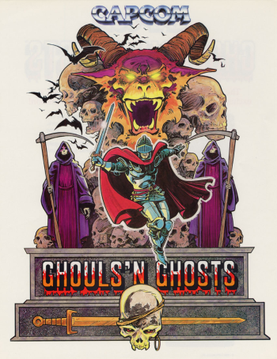
Ghouls 'n Ghosts, known as Dai Makaimura in Japan, is a side-scrolling platform game developed by Capcom, released as an arcade video game in 1988 and ported to home platforms. It is the sequel to Ghosts 'n Goblins and the second game in the Ghosts 'n Goblins series.

Columns is a match-three puzzle video game released by Sega in 1990. Designed by Jay Geertsen, it was released by Sega for arcades and then ported to several Sega consoles. The game was subsequently ported to home computer platforms, including the Atari ST.

Altered Beast is a 1988 beat 'em up arcade video game developed and published by Sega. The game is set in Ancient Greece and follows a player character chosen by Zeus to rescue his daughter Athena from the demonic ruler of the underworld, Neff. Through the use of power-ups, the player character can assume the form of different magical beasts. It was ported to several home video game consoles and home computers. It was the pack-in game for the Mega Drive when that system launched in 1988.
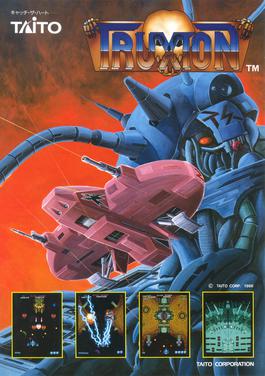
Truxton is a 1988 vertically scrolling shooter arcade video game originally developed by Toaplan and published in Japan and Europe by Taito, as well as in North America by Midway. Set in a future where the Gidans alien race led by Dogurava invaded the fictional planet Borogo, players assume the role of fighter pilot Tatsuo taking control of the Super Fighter ship on a last-ditch effort to overthrow the alien invaders.
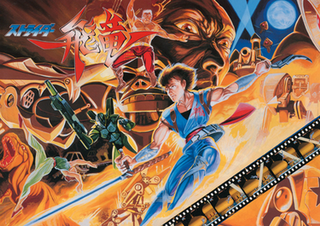
Strider, released in Japan as Strider Hiryū, is a hack-and-slash platform game released in arcades in 1989 by Capcom. Set in a dystopian future where Earth is ruled by the tyrannical Grandmaster Meio, it follows the titular Strider named Hiryu as he attempts to end his tyrannical reign for good. The game resulted from cooperation between Capcom and manga publisher Moto Kikaku. It marked the video game debut of Strider Hiryu, after the character was introduced in the 1988 manga Strider Hiryu.
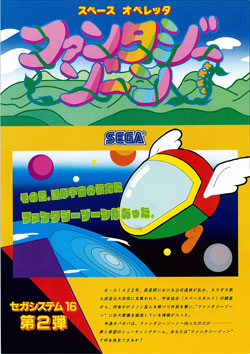
Fantasy Zone is a 1986 arcade video game by Sega, and the first game in the Fantasy Zone series. It was later ported to a wide variety of consoles, including the Master System. The player controls a sentient spaceship named Opa-Opa who fights an enemy invasion in the titular group of planets. The game contains a number of features atypical of the traditional scrolling shooter. The main character, Opa-Opa, is sometimes referred to as Sega's first mascot character.

Golden Axe is a side-scrolling hack-and-slash video game released by Sega for arcades in 1989, running on the Sega System 16B arcade hardware. Makoto Uchida was the lead designer of the game, and was also responsible for the creation of the previous year's Altered Beast. The game casts players as one of three warriors who must free the fantastical land of Yuria from the tyrannical rule of Death Adder, who wields the titular Golden Axe.
Michael Jackson's Moonwalker is the name of several video games based on the 1988 Michael Jackson film Moonwalker. Sega developed two beat 'em ups, released in 1990; one released in arcades and another released for the Sega Genesis and Master System consoles. U.S. Gold also published various games for home computers the same year. Each of the games' plots loosely follows the "Smooth Criminal" segment of the film, in which Jackson rescues kidnapped children from the evil Mr. Big, and incorporates synthesized versions of some of the musician's songs. Following Moonwalker, Jackson collaborated with Sega on several other video games.

Flicky is a platform game developed by Sega and released as an arcade video game in May 1984. It was licensed to Bally Midway for distribution in the United States. In Flicky, the player controls the eponymous blue bird and must gather all the small birds called Chirps in each round and bring them safely to the exit. There are cat and lizard enemies which can disperse the Chirps and kill the player, but Flicky can use items on the playing field to protect herself and the Chirps from danger.

The Revenge of Shinobi, released in Japan as The Super Shinobi, is a hack-and-slash action video game developed and published by Sega in 1989. It was the first Shinobi game developed for the Sega Genesis, and was later released on the coin-operated version of that console, the Mega-Tech.

Streets of Rage 2, known as Bare Knuckle II in Japan, is a 1992 side-scrolling beat 'em up video game published by Sega for the Genesis/Mega Drive. A sequel to Streets of Rage (1991), the characters Axel Stone and Blaze Fielding return while the game also introduces two new characters: Max Thunder, and Eddie "Skate" Hunter, the younger brother of Adam Hunter from the first game.

Bonanza Bros. is a 3D-style, 2D side-scrolling stealth action game developed and released by Sega in 1990. It is one of the earliest arcade games powered by the Sega System 24 arcade system board. It was ported to various home systems, including the Mega Drive/Genesis, Master System, PC-Engine/TurboGrafx-CD, and several home computers.

Castle of Illusion Starring Mickey Mouse is a 1990 platform game developed and published by Sega and released for the Mega Drive/Genesis. An 8-bit version of the game was later released for the Master System and Game Gear. The game follows Mickey Mouse on a quest to save Minnie Mouse from the evil witch Mizrabel. It is the first game in Sega's Illusion video game series starring Mickey.

The Sega Genesis, also known as the Mega Drive outside North America, is a 16-bit fourth generation home video game console developed and sold by Sega. It was Sega's third console and the successor to the Master System. Sega released it in 1988 in Japan as the Mega Drive, and in 1989 in North America as the Genesis. In 1990, it was distributed as the Mega Drive by Virgin Mastertronic in Europe, Ozisoft in Australasia, and Tectoy in Brazil. In South Korea, it was distributed by Samsung Electronics as the Super Gam*Boy and later the Super Aladdin Boy.
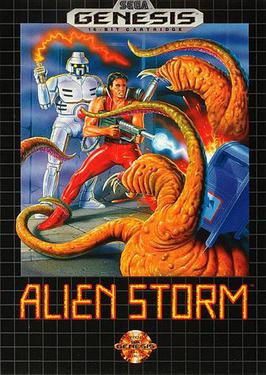
Alien Storm (エイリアンストーム) is a beat 'em up shooter released as an arcade video game by Sega in 1990. It was ported to the Genesis/Mega Drive and Master System. The Mega Drive version was re-released on Wii's Virtual Console in 2007 and was also included on Sonic's Ultimate Genesis Collection for Xbox 360 and PlayStation 3. The game was also re-released on the Nintendo Switch Online + Expansion Pack in 2022.

Shadow Dancer: The Secret of Shinobi, also known simply as Shadow Dancer, is a side-scrolling action game developed and published by Sega for the Sega Genesis in 1990. It is the second game in the Shinobi series released for the Mega Drive, following The Revenge of Shinobi. However, it is not a continuation of the previous game, but rather a loose adaptation of the 1989 arcade game Shadow Dancer. Like in the original arcade game, the player controls a ninja followed by a canine companion. The Secret of Shinobi was well received by critics.
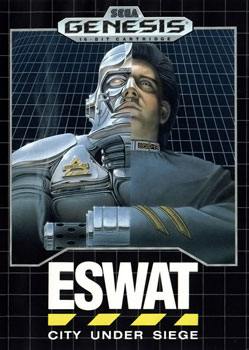
ESWAT: City Under Siege, released in Japan as Cyber Police ESWAT, is a 1990 side scrolling action platform video game developed and published by Sega for the Sega Genesis and Sega Master System video game consoles.
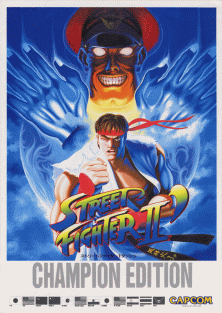
Street Fighter II: Champion Edition, released as Street Fighter II Dash in Japan, is a fighting game released by Capcom in 1992. It was launched for arcades and converted to several video game consoles. It is the first of several updated versions of Street Fighter II, and part of the Street Fighter series. The main changes are the addition of the four grand masters as playable characters and mirror matches. The fighting techniques of the eight main characters from the original game were further balanced for competitive play.


















